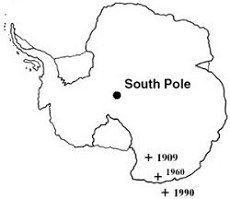
| Glasgow Digital Library | Voyage of the Scotia | BRUCE | PEOPLE | SHIP | ANTARCTIC | INDEX |
|---|

The north and south magnetic poles are the two points on the Earth's surface where the compass needle points vertically up and down. They are not stationary and move from 10-15 kilometres (six to nine miles) each year.
In 1841 James Clark Ross reached the North Magnetic Pole and had hoped to reach the South Magnetic Pole in 1843. The South Magnetic Pole was at this time on the polar plateau over 8,000 feet above sea level.
The South Magnetic Pole was eventually reached on 16 January 1909 by a party from the Shackleton expedition: two Australian geologists Edgeworth David and Douglas Mawson along with Scottish doctor Alistair Mackay.
During Amundsen's voyage through the Northwest Passage on his ship Gjøa, magnetic observations were made. Although unsuccessful in reaching the North Magnetic Pole, he proved that the magnetic poles were not fixed and moved slowly all the time.
| Glasgow Digital Library | Voyage of the Scotia | BRUCE | PEOPLE | SHIP | ANTARCTIC | INDEX |
|---|